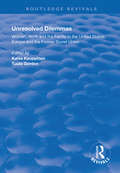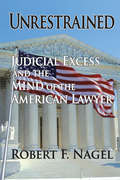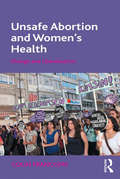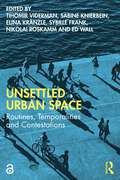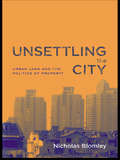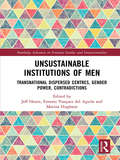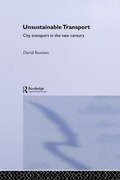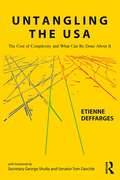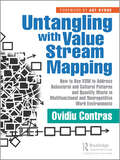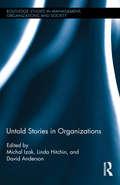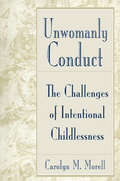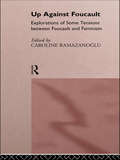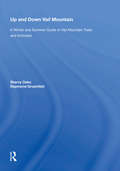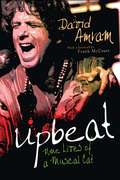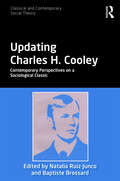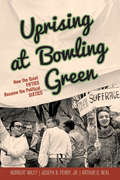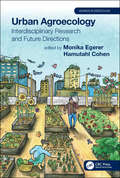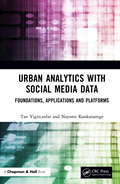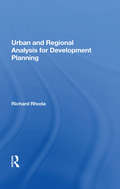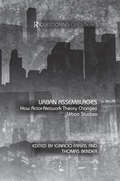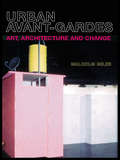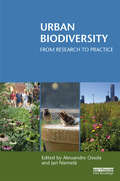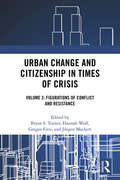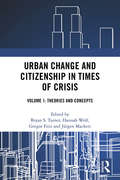- Table View
- List View
Unresolved Dilemmas: Women, Work and the Family in the United States, Europe and the Former Soviet Union (Routledge Revivals)
by Kaisa Kauppinen Tuula GordonOriginally printed in 1997. Women are a considerable portion of the labour force. The majority of them also establish relationships and become mothers. Combining work and family has created considerable problems for women, domestic circumstances and main responsibility for housework and children still affect women, meaning they enter the labour market with one hand tied behind their back. How do women today cope with the dilemmas caused by their dual roles? This book takes a critical look at the concept of dual roles, and makes an assessment of women's locations in the workplace and at home, considering both continuities and change. The book concentrates on a wide variety of issues around work, family and their interrelationships. Unresolved dilemmas from different cross-cultural perspectives are considered, integrating the problems of modern women.
Unrestrained: Judicial Excess and the Mind of the American Lawyer
by Robert F. NagelRobert Nagel's innovative volume attempts to explain why, despite almost four decades of conservative and moderate appointments, the Supreme Court continues to intervene aggressively in a wide array of social and political issues. The explanation lies primarily in the psychological effects of the way that lawyers think about law and judging. The instincts ingrained by the experiences common to legal education and the successful practice of law also work to encourage the reckless use of power.Nagel argues that the problem with the modern judicial role is cultural and political. He demonstrates that judges, especially Supreme Court justices, have degraded our political discourse, intensified social conflict, and drained moral confidence.By examining modern Supreme Court confirmation hearings along with certain classic legal writings, Nagel shows how modern lawyers have a broad consensus on how to interpret the Constitution and, more generally, how to think about law. One major component of this mindset is to combine realism with legalism in ways that naturally tend to expand the judiciary's imperial role. Realism counsels that decisions are inevitably partly personal and therefore cannot be conclusively justified while legalism imparts the sense that the judge's interpretation is the best one possible. This combination of the personal and political, along with other aspects of modem legal thinking and training, means that judges are not only unconstrained by professional norms but actually are impelled by them to use power expansively.This issue is important to every person living in the U.S., as the Supreme Court's decisions concern everyone in the nation. It has the potential to be read by lawmakers, lawyers, students of law and political science, and anyone interested in Constitutional law. The thesis is unique and the execution is precise.
Unsafe Abortion and Women's Health: Change and Liberalization
by Colin FrancomeUnsafe abortion remains one of the most neglected sexual and reproductive health problems according to the World Health Organisation. In recent years it has been estimated that nearly 44 million abortions occur annually leading to around 47,000 deaths. At this rate a woman will die of an unsafe abortion every 11 minutes. Bringing together a wealth of information from around the world, this book argues that the time has come for a great change in legislation, advocating a shift towards the legalization of abortion to improve the health of women in poorer countries. With attention to circumstances in each of the major continental regions, an outline of the global situation is provided to reveal the major trends in the provision and procurement of abortion, as well their effects. Presenting data drawn from over a hundred countries covering over ninety per cent of the world’s population, based on published statistical information, changes to legal frameworks, court cases and the accounts of local commentators and activists, Unsafe Abortion and Women's Health will be of interest to scholars and students of the sociology of medicine, gender and reproductive health, social and health policy and feminist studies.
Unsettled Urban Space: Routines, Temporalities and Contestations
by Sabine Knierbein Ed Wall Tihomir Viderman Sybille Frank Nikolai Roskamm Elina KränzleWhile urban life can be characterized by endeavors to settle stable and safe environments, for many people, urban space is rarely stable or safe; it is uncertain, troubled, imbued with challenges and perpetually under pressure. As the concept of unsettled appears to define the contemporary urban experience, this multidisciplinary book investigates the conflicts and possibilities of settling and unsettling through open and speculative analysis. The analytical prism of unsettled renders urban space an indeterminate ground unfolding through routines, temporalities and contestations in constant tension between settling and unsettling. Such contrasting experiences are contingent on how urban societies confront, undergo and overcome turbulence and difficulties in time and space. Contributions drawing on theoretical reflections and empirical accounts—from Argentina, Austria, Germany, Greece, Italy, the Netherlands, the UAE, the UK, the USA and Vietnam—give insights into plural occurrences of the unsettled, which might tie down or unleash transformative, liberatory and emancipatory potentials. This book is for students, professionals and researchers interested in the uncertainties, foundations, disturbances, inconsistencies, residuals and blind fields, which constitute the urban both as lived space and as social, cultural and political ideal.
Unsettling the City: Urban Land and the Politics of Property
by Nicholas BlomleyShort and accessible, this book interweaves a discussion of the geography of property in one global city, Vancouver, with a more general analysis of property, politics, and the city.
Unsustainable Institutions of Men: Transnational Dispersed Centres, Gender Power, Contradictions (Routledge Advances in Feminist Studies and Intersectionality)
by Jeff Hearn Ernesto Vasquez del Aguila Marina HughsonHow are men, masculinities and gender power implicated within global institutions? How are global institutions to be understood in terms of men, masculinities and gender power? What are men up to in such arenas as: global finance, corporate law, military intelligence, world sporting bodies and nationalist politics? Unsustainable Institutions of Men examines men’s dealings in transnational processes across the economy, politics, technologies and bodies. In exploring the men’s domination of institutions in national and transnational realms this volume underpins a novel approach built around multiple "dispersed centres" of men’s power. Indeed, in critical discussions of men and masculinities there has been a gradual shift in focus from the local, so-called ‘ethnographic moment’, to a broader view encompassing several dynamics (e.g. global, transnational, international, postcolonial and the global north-south). Building on this conceptual move, Unsustainable Institutions of Men focuses on pinpointing masculine actions and influences that support and enact transnational processes, disclosing those connections and examining institutional alternatives which could contribute to more inclusive and democratic transnational dialogues. Comprised of a range of international contributions, Unsustainable Institutions of Men will appeal to students, researchers, experts and activists seeking to understand the deep structural conditions of contemporary globalized threats, created by old and new patterns of gender power and transnational patriarchies.
Unsustainable Transport: City Transport in the New Century (Transport, Development and Sustainability Series)
by David BanisterThis book addresses the links between transport and sustainable urban development, from an analysis of the global picture to issues in transport and energy intensity, public policy and the institutional and organisational constraints on change. The central part of the book explores these links in more detail at city level, covering land use and development, economic measures, and the role that technology can play. The final part looks for inspiration from events in developing countries and the means by which we can move from the unsustainable present to a more sustainable future.
Untangling the USA: The Cost of Complexity and What Can Be Done About It
by Etienne DeffargesTom Brady and the “tuck rule”; “Nobody knew health care could be so complicated”; “The financial world has become way too complicated and very secretive.” What could Tom Brady, Donald Trump, and Michael Lewis possibly have in common? Complexity. Lewis has analyzed it; Trump has discovered it; Brady has benefited from it. And the USA is entangled in it. Complex systems are an inevitable part of business and socio-economic structures. We reach a breaking point, however, when social and organizational structures become cumbersome and unintelligible. Entire new systems need to be constructed just to manage this complexity, with questionable or negative value to society at large. The outcome is high costs, poor results, deepening social inequality, and the erosion of public trust. Wholesale changes must be contemplated. This is particularly true in the USA today, where complexity is piled upon complexity in a number of critical sectors, such as health care, energy, finance, and government. The author takes a common sense, broad-based, and analytical approach to some of the most complicated issues facing the US today. He examines the costs of complexity through a wide-angle lens, provides analysis of the root causes involved, and explains what is necessary to improve results and lower costs. The ever-increasing level of complexity in the US is compared to that in other developed economies. History is referenced as a guide to show that in many areas, America’s success has relied on simple and elegant solutions. These contrasting paths are used to propose alternative approaches and new solutions. Beyond analyzing how incredibly complex socio-economic systems have emerged in recent years in the US, the author steps back, reflects on the fundamental values of this country, and offers a number of actionable proposals to improve the lives of all American citizens. Etienne Deffarges has enjoyed a successful career, first as a senior strategy consultant to many leading global companies, then as a heath care technology entrepreneur in the US. He is perfectly positioned to observe how complex systems are stifling socio-economic progress. He brings a unique insider view of the issues involved and examines a number of key sectors that impact American society at large, including health care, energy, finance, regulations, taxation, utilities, and welfare.
Untangling with Value Stream Mapping: How to Use VSM to Address Behavioral and Cultural Patterns and Quantify Waste in Multifunctional and Nonrepetitive Work Environments
by Ovidiu ContrasThe standard belief in books about Lean initiatives and value stream mapping (VSM) is that VSM works well on transactional processes (which are primarily linear processes where handoffs are well defined and the outcome is known) and it is useful for repetitive projects or products. This book counters these statements by clearly demonstrating how a VSM exercise can be successfully performed in complex, multifunctional environments involving nonrepetitive work, such as aircraft new product development, custom engineering, software development and project management. The methodology described in this book is the result of more than ten years of refinement and is based on practice while working with multidisciplinary teams and helping them achieve their goals. This is a novel approach to capturing the information flow in a VSM by recognizing it as the place where most of the issues are generated, especially for the previously mentioned environments and the fact that classical mapping methodologies (including classical VSM) do not capture it well. The VSM methodology that the author developed goes to the essence of a VSM (activities flow, information flow, timeline), uses conventional VSM icons and some custom information flow icons and helps the following: Quantifying waste (VSM literature gap) Making disconnects visible (VSM literature gap) Making behavioral and cultural patterns visible (VSM literature gap) If the steps are followed thoroughly, then lead time reductions ranging from 60% to 88% are achieved, along with increased availability of resources, more output with the same resources, projects delivered on time and, most importantly, colleagues embracing the Lean mindset, which greatly contributes to maintaining the gains. Essentially, this book helps readers perform a VSM in environments where multiple stakeholders interact with each other to deliver a product or a service with unclear aspects, such as what the product/service is, how all involved can contribute to the product or service transformation and how the interactions between them occur. For example, the products/services targeted in this book include test results, analysis results, a custom design, a process, a methodology, an engineering change, integrated enterprise software and engineering drawings. Concurrently, this book helps readers map behavioral patterns, such as micromanagement, and company culture aspects, such as excessive governance and "decisions by committee."
Untangling with Value Stream Mapping: How to Use VSM to Address Behavioral and Cultural Patterns and Quantify Waste in Multifunctional and Nonrepetitive Work Environments
by Ovidiu ContrasThe standard belief in books about Lean initiatives and value stream mapping (VSM) is that VSM works well on transactional processes (which are primarily linear processes where handoffs are well defined and the outcome is known) and it is useful for repetitive projects or products. This book counters these statements by clearly demonstrating how a VSM exercise can be successfully performed in complex, multifunctional environments involving nonrepetitive work, such as aircraft new product development, custom engineering, software development and project management. The methodology described in this book is the result of more than ten years of refinement and is based on practice while working with multidisciplinary teams and helping them achieve their goals. This is a novel approach to capturing the information flow in a VSM by recognizing it as the place where most of the issues are generated, especially for the previously mentioned environments and the fact that classical mapping methodologies (including classical VSM) do not capture it well. The VSM methodology that the author developed goes to the essence of a VSM (activities flow, information flow, timeline), uses conventional VSM icons and some custom information flow icons and helps the following: Quantifying waste (VSM literature gap) Making disconnects visible (VSM literature gap) Making behavioral and cultural patterns visible (VSM literature gap) If the steps are followed thoroughly, then lead time reductions ranging from 60% to 88% are achieved, along with increased availability of resources, more output with the same resources, projects delivered on time and, most importantly, colleagues embracing the Lean mindset, which greatly contributes to maintaining the gains.Essentially, this book helps readers perform a VSM in environments where multiple stakeholders interact with each other to deliver a product or a service with unclear aspects, such as what the product/service is, how all involved can contribute to the product or service transformation and how the interactions between them occur. For example, the products/services targeted in this book include test results, analysis results, a custom design, a process, a methodology, an engineering change, integrated enterprise software and engineering drawings.Concurrently, this book helps readers map behavioral patterns, such as micromanagement, and company culture aspects, such as excessive governance and "decisions by committee."
Untold Stories in Organizations (Routledge Studies in Management, Organizations and Society)
by David Anderson Michal Izak Linda HitchinThe field of organizational storytelling research is productive, vibrant and diverse. Over three decades we have come to understand how organizations are not only full of stories but also how stories are actively making, sustaining and changing organizations. This edited collection contributes to this body of work by paying specific attention to stories that are neglected, edited out, unintentionally omitted or deliberately left silent. Despite the fact that such stories are not voiced they have a role to play in organizational analysis. The chapters in this volume variously explore how certain realities become excluded or silenced. The stories that remain below the audible range in organizations offer researchers an access to study political practices which marginalise certain organisational realities whilst promoting others. This volume offers a further contribution by paying heed to silence and the processes of silencing. These silences influence the choice of issues on organisational agendas, the choice of audience(s) to which these discourses are addressed and the ways of addressing them. In exploring these relatively understudied terrains, Untold Stories in Organizations comprises an important contribution to the organizational storytelling space, opening paths for new trajectories in storytelling research.
Unwomanly Conduct: The Challenges of Intentional Childlessness
by Carolyn Mackelcan MorellFirst published in 1994. Routledge is an imprint of Taylor & Francis, an informa company.
Up Against Foucault: Explorations of Some Tensions Between Foucault and Feminism
by Caroline RamazanogluUp Against Foucault introduces key aspects of Foucault's work to feminists, in ways which are less abstracted than much of the existing literature in this area. It includes an introduction to Foucault's terms, and fills a gap in the literature by clarifying the links between the everyday realities of women's lives and Foucault's work on sexuality and power. The contributors explore the implications of analysing power relations, sexuality or the body, without also thinking about gender and other social divisions. They bring their expertise from social theory and philosophy to bear on the same core issues; the ways in which Foucault provokes feminists into questioning their grasp of power relations, and the implications of the absence of gender in his own work. Up Against Foucault shows that in spite of his lack of interest in gender, Foucault does have much to offer feminism - proposing new ways of understanding the control of women and especially the control of sexuality and bodies. This book offers new ground in relating Foucault's challenge to feminism to feminisms challenge to Foucault. Feminists are up against Foucault because he questions the key conclusions which feminists have come to about the nature of gender relations, and men's possession of power. It is an appraisal of how seriously we need to take this challenge.
Up And Down Vail Mountain
by E. Lawerence OaksAs Vail's Bob Parker tells the story, the only difference between the early days of Vail and those of the mining towns in Colorado nearly a hundred years earlier was that Vail's gold was white. Otherwise the scene was similar-the streets were dirt covered, the bars were rowdy, buildings were being constructed everywhere, and the same self-starting and chance-taking spirit prevailed. If you are new to Vail this book should serve as a guide to the trails and special features that you'll find here. If you've been to Vail before, it's possible that you've missed a run that might be perfect for you or a special feature that will help complete your skiing day. If you're an old timer, there may be new programs you're not aware of or perhaps a secluded part of Vail Mountain you haven't discovered.
Upbeat: Nine Lives of a Musical Cat
by David AmramDavid Amram-composer, jazz artist, conductor, and world music pioneer-has been described by the Boston Globe as "the Renaissance man of American music." From early collaborations with Kerouac and Sinatra, chosen by Leonard Bernstein as the New York Philharmonic's first composer in residence, Amram's artistry has taken him from concerts with Willie Nelson to jamming with the Massai tribe of Kenya. In Upbeat: Nine Lives of a Musical Cat, Amram recounts his extraordinary adventures in the many worlds of music he calls home, all told in a rollicking anecdotal style that makes you feel that you are at home around the world. He writes, "Everywhere I have been in the world, music transcends politics. As musicians, we were able to go beyond all that and just be fellow human beings." Threading through Amram's tale of music, hard work, respect, and friendship are unforgettable stories of fellow great artists-Dizzie Gillespie, Hunter S. Thompson, Janet Gaynor, George Plimpton, Lyle Lovett, Zoe Caldwell, Willie Nelson, and many more.
Updating Charles H. Cooley: Contemporary Perspectives on a Sociological Classic (Classical and Contemporary Social Theory)
by Baptiste Brossard Natalia Ruiz-JuncoThis book explores the contemporary relevance of Charles H. Cooley’s thought, bringing together scholars from the US, Europe and Australia to reflect on Cooley’s theory and legacy. Offering an up-to-date analysis of Cooley’s reception in the history of the social sciences, an examination of epistemological and methodological advances on his work, critical assessments and novel articulations of his major ideas, and a consideration of new directions in scholarship that draws on Cooley’s thought, Updating Charles H. Cooley will appeal to sociologists with interests in social theory, interactionism, the history of sociology, social psychology, and the sociology of emotions.
Uprising at Bowling Green: How the Quiet Fifties Became the Political Sixties
by Norbert Wiley Arthur G. Neal Joseph B Perry JrOften overlooked, the student demonstration at Bowling Green State University was the first and most successful 1960s campus protest - and a key point in the transition from 1950s social mores to 1960s activism. What began as a protest against outdated rules about dating and student behaviour quickly turned toward political objectives about civil liberties and ousted the university president. The authors, two of whom were present on campus during the demonstration, tell the story of how what began as dissent against old schoolmarm rules quickly turned into a fully-fledged 1960s crusade, with new issues and tactics. Feminist activists played a leading role, and the uprising succeeded in advancing the civil liberties of women. Drawing on the sociological ideas of Weber, Durkheim, and Marx, this book depicts how young activists broke the 1950s mold, little aware that many of their ideals would be echoed in many important 1960s protests. It is a vivid portrait of how the 1950s became the 1960s in America.
Urban Agroecology: Interdisciplinary Research and Future Directions (Advances in Agroecology #23)
by Monika Egerer Hamutahl CohenToday, 20 percent of the global food supply relies on urban agriculture: social-ecological systems shaped by both human and non-human interactions. This book shows how urban agroecologists measure flora and fauna that underpin the ecological dynamics of these systems, and how people manage and benefit from these systems. It explains how the sociopolitical landscape in which these systems are embedded can in turn shape the social, ecological, political, and economic dynamics within them. Synthesizing interdisciplinary approaches in urban agroecology in the natural and social sciences, the book explores methodologies and new directions in research that can be adopted by scholars and practitioners alike. With contributions from researchers utilizing both social and natural science approaches, Urban Agroecology describes the current social-environmental understandings of the science, the movement and the practices in urban agroecology. By investigating the role of agroecology in cities, the book calls for the creation of spaces for food to be sustainably grown in urban spaces: an Urban Agriculture (UA) movement. Essential reading for graduate students, practitioners, policy makers and researchers, this book charts the course for accelerating this movement.
Urban Analytics with Social Media Data: Foundations, Applications and Platforms
by Tan Yigitcanlar Nayomi KankanamgeThe use of data science and urban analytics has become a defining feature of smart cities. This timely book is a clear guide to the use of social media data for urban analytics. The book presents the foundations of urban analytics with social media data, along with real-world applications and insights on the platforms we use today. It looks at social media analytics platforms, cyberphysical data analytics platforms, crowd detection platforms, City-as-a-Platform, and city-as-a-sensor for platform urbanism. The book provides examples to illustrate how we apply and analyse social media data to determine disaster severity, assist authorities with pandemic policy, and capture public perception of smart cities. This will be a useful reference for those involved with and researching social, data, and urban analytics and informatics.
Urban And Regional Analysis For Development Planning
by Richard RhodaDr. Rhoda concisely presents the wide range of analytical methods available to urban and regional development planners. Focusing on the needs of the practitioner, in each chapter he concentrates on a particular analytical issue, describing several types of relevant analyses and offering guidelines for selecting appropriate techniques to solve speci
Urban Assemblages: How Actor-Network Theory Changes Urban Studies (Questioning Cities)
by Thomas Bender Ignacio FaríasThis book takes it as a given that the city is made of multiple partially localized assemblages built of heterogeneous networks, spaces, and practices. The past century of urban studies has focused on various aspects—space, culture, politics, economy—but these too often address each domain and the city itself as a bounded and cohesive entity. The multiple and overlapping enactments that constitute urban life require a commensurate method of analysis that encompasses the human and non-human aspects of cities—from nature to socio-technical networks, to hybrid collectivities, physical artefacts and historical legacies, and the virtual or imagined city. This book proposes—and its various chapters offer demonstrations—importing into urban studies a body of theories, concepts, and perspectives developed in the field of science and technology studies (STS) and, more specifically, Actor-Network Theory (ANT). The essays examine artefacts, technical systems, architectures, place and eventful spaces, the persistence of history, imaginary and virtual elements of city life, and the politics and ethical challenges of a mode of analysis that incorporates multiple actors as hybrid chains of causation. The chapters are attentive to the multiple scales of both the object of analysis and the analysis itself. The aim is more ambitious than the mere transfer of a fashionable template. The authors embrace ANT critically, as much as a metaphor as a method of analysis, deploying it to think with, to ask new questions, to find the language to achieve more compelling descriptions of city life and of urban transformations. By greatly extending the chain or network of causation, proliferating heterogeneous agents, non-human as well as human, without limit as to their enrolment in urban assemblages, Actor-Network Theory offers a way of addressing the particular complexity and openness characteristic of cities. By enabling an escape from the reification of the city so common in social theory, ANT’s notion of hybrid assemblages offers richer framing of the reality of the city—of urban experience—that is responsive to contingency and complexity. Therefore Urban Assemblages is a pertinent book for students, practitioners and scholars as it aims to shift the parameters of urban studies and contribute a meaningful argument for the urban arena which will dominate the coming decades in government policies.
Urban Avant-Gardes: Art, Architecture and Change
by Malcolm MilesUrban Avant-Gardes presents original research on a range of recent contemporary practices in and between art and architecture giving perspectives from a wide range of disciplines in the arts, humanities and social sciences that are seldom juxtaposed, it questions many assumptions and accepted positions. This book looks back to past avant-gardes from the nineteenth and twentieth centuries examining the theoretical and critical terrain around avant-garde cultural interventions, and profiles a range of contemporary cases of radical cultural practices. The author brings together material from a wide range of disciplines to argue for cultural intervention as a means to radical change, while recognizing that most such efforts in the past have not delivered the dreams of their perpetrators. Distinctive in that it places works of the imagination in the political and cultural context of environmentalism, this book asks how cultural work might contribute to radical social change. It is equally concerned with theory and practice - part one providing a theoretical framework and part two illustrating such frameworks with examples.
Urban Biodiversity: From Research to Practice (Routledge Studies in Urban Ecology)
by Alessandro Ossola Jari NiemeläUrban biodiversity is an increasingly popular topic among researchers. Worldwide, thousands of research projects are unravelling how urbanisation impacts the biodiversity of cities and towns, as well as its benefits for people and the environment through ecosystem services. Exciting scientific discoveries are made on a daily basis. However, researchers often lack time and opportunity to communicate these findings to the community and those in charge of managing, planning and designing for urban biodiversity. On the other hand, urban practitioners frequently ask researchers for more comprehensible information and actionable tools to guide their actions. This book is designed to fill this cultural and communicative gap by discussing a selection of topics related to urban biodiversity, as well as its benefits for people and the urban environment. It provides an interdisciplinary overview of scientifically grounded knowledge vital for current and future practitioners in charge of urban biodiversity management, its conservation and integration into urban planning. Topics covered include pests and invasive species, rewilding habitats, the contribution of a diverse urban agriculture to food production, implications for human well-being, and how to engage the public with urban conservation strategies. For the first time, world-leading researchers from five continents convene to offer a global interdisciplinary perspective on urban biodiversity narrated with a simple but rigorous language. This book synthesizes research at a level suitable for both students and professionals working in nature conservation and urban planning and management.
Urban Change and Citizenship in Times of Crisis: Figurations of Conflict and Resistance
by Jürgen Mackert Gregor Fitzi Hannah Wolf Bryan TurnerAt times of triumphant neo-liberalism cities increasingly become objects of financial speculation. Formally, social and political rights might not be abolished, yet factually they have become inaccessible for large parts of the population. The contributions gathered in this volume shed light on the clash between the perspectives of restructuring and reordering urban environments in the interest of investors and the manifold and innovative agencies of resistance that claim and stand up for the rights of urban citizenship. Renewed waves of urban transformation employ state coercion to foster the expulsion of poor and marginalised inhabitants from those urban spaces that attract interest from speculators. The intervention of state agencies triggers the work of hegemonic culture for reframing the housing issue and implementing moral and political legitimation, as well as legislation that restricts urban citizenship rights. The case studies of the volume comparatively show the different and sometimes contradictory patterns of these conflicts in Berlin, Sydney, Belfast, Jerusalem, Amsterdam, and İstanbul as well as in metropoles of Latin America and China. Innovative resistance agencies emerge that paint possible paths for the re-establishment of the right to the city as the core of urban citizenship.
Urban Change and Citizenship in Times of Crisis: Theories and Concepts
by Jürgen Mackert Gregor Fitzi Hannah Wolf Bryan TurnerUrban Change and Citizenship in Times of Crisis addresses the fact that in the beginning of the twenty-first century the majority of the world’s population is urbanised, a social fact that has turned cities more than ever into focal sites of social change. Multiple economic and political strategies, employed by a variety of individual and collective actors, on a number of scales, constitute cities as contested spaces that hold opportunities as well as restrictions for their inhabitants. While cities and urban spaces have long been of central concern for the social sciences, today, classical sociological questions about the city acquire new meaning: Can cities be spaces of emancipation, or does life in the modern city entail a corrosion of citizenship rights? Is the city the focus of societal transformation processes, or do urban environments lose importance in shaping social reality and economic relationships? Furthermore, new questions urgently need to be asked: What is the impact of different historical phenomena such as neo-liberal restructuring, financial and economic crises, or migration flows, as well as their respective counter-movements, on the structure of contemporary cities and on the citizenship rights of city inhabitants? The three volumes address such crucial questions thereby opening up new spaces of debate on both the city and new developments of urbanism. The contributions to Theories and Concepts offer new theoretical reflections on the city in a philosophical and historical perspective as well as fresh empirical analyses of social life in urban contexts. Chapters not only critically revisit classical and modern philosophical considerations about the nature of cities but no less discuss normative philosophical reflections of urban life and the role of religion in historical processes of the emergence of cities. Composed around the question whether there can be such a thing as a ‘successful city’, this volume addresses issues of urban political subjectivities by considering the city’s role in historical processes of emancipation, the fight for citizenship rights, and today’s challenges and opportunities with regard to promoting social justice, integration, and diversity. Consequentially, theory-driven empirical analyses offer new insight into ways of solving problems in urban contexts and a genuine approach to analyse the Social Quality in cities.
